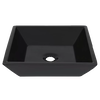How to select the right bathroom sink
The bathroom sink you choose will have a major impact on the look of your bathroom. However, since the bathroom is a functional space, it’s not just the aesthetics that count. If you have a large family, the bathroom basin will see a lot of action every day. Most importantly, your ideal sink should be convenient and comfortable to use.
However, choosing the right sink for your bathroom is not easy. There’s a wide range of bathroom sinks on the market and many things to consider, from the different materials and shapes to styles. Take time to choose a bathroom basin that will work for you. The size of your bathroom will also influence your choice of sink.
Whether you’re building a new home or remodeling your bathroom, this easy guide will help you choose the right sink for your bathroom. So, read on!
What bathroom sink types are there to choose from?
There are a few different types of bathroom sinks based on mounting options, shape, and so on. Here are the most common types of bathroom sinks you’ll find on the market.
Drop-in bathroom sinks
Also known as self-rimming or top-mount, drop-in sinks are one of the most common bathroom sinks. As the name suggests, these sinks are designed to sit into a cutout in the worktop while the rim rests against the surface of the worktop. The rim is secure to the worktop with silicone or mounting clips. However, when installing a drop-in sink, care must be taken because space between the worktop and the rim can accumulate dirt and become a haven for mold.
Undermount bathroom sinks
These sinks are installed beneath the surface of the worktop, making for a clean drop-off from the worktop. They also allow for easy worktop cleaning. The plumbing is also concealed behind the vanity. However, this installation type leaves the edge of the worktop exposed, so ensure your worktop is waterproof. Because the cutout on the worktop needs to be precise, replacing an undermount sink may be more difficult than other sink types. So, when looking for a replacement, ensure you have the exact measurements of the cutout and look at the manufacturer's specification of the replacement undermount. These sinks are great for busy family bathrooms.
Pedestal bathroom sinks
Traditional, space-saving, and stylish pedestal bathroom sink units are the classic option and probably what most people recognize. The main advantage of pedestal bathroom sinks is that they hide away plumbing, leaving you with a clean finish. Since the basin is supported by a fixture mounted to the wall, the pedestal doesn’t take the weight of the basin. The major drawback of these sinks is that they don't have space around the sink for storing toiletries. Since there is no vanity under the sink, the storage space in the bathroom is significantly reduced.
Wall-mounted bathroom sinks
These bathroom basins hang from the wall, making them a great choice for bathrooms with limited space. They don't need to sit in or on a worktop. They look streamlined and give your bathroom a minimalistic feeling. The pipework is often exposed but can also be concealed behind the wall. However, wall-mounted bathroom sinks don't have storage space, and they don't have a 'landing' space because they don't have a worktop.
Vessel bathroom sinks
Vessel, or above-counter sinks, sit on top of the worktop, although there are units that sit partially below the worktop. This bathroom basin looks like a separate bowl that could easily be picked and moved. Adding vessel sinks to your bathroom is a great way to create a modern and luxurious look. Most importantly, they work well with different bathrooms. Unlike bathroom sinks that are either installed below the worktop, vessel sinks demand attention and can be used as a statement-making piece in a bathroom. The main downside of these is cleaning around the base. Vessel sinks are best suited for master bathrooms.
What material should you choose for your bathroom sink?
Bathroom sinks come in a variety of materials. The material you choose will determine the visual flair and durability of your bathroom basin. It’s for this reason that material selection is one of the most important points to keep in mind when choosing a bathroom basin. Below, we look at the various materials you can choose for your bathroom basin.
Ceramic
A classic choice, ceramic bathroom basins are known for their lasting shine. Their color remains unchanged even when cleaned with products such as bleach. Most of these sinks are recycled, so they are a good choice for environmentally conscious people. If you're looking for something simple, go for a ceramic bathroom sink unit. They aren’t available in different colors, but you can find units with decorative motifs or even matte finish. However, it's a fragile material, so ensure you handle it with care.
Stone
Stone bathroom basins are made from materials like granite, sandstone, travertine, or marble. Bathroom basins made from stone are usually heavier. The different types of stone have unique traits, including color variation, flecks of minerals, and veining. Some stones are shaped and polished, while others are left unfinished to add dramatic contrast to your bathroom. However, stone bathroom basins require more maintenance because of the porosity of stone. Watch out for stains like rust that can be caused by leaving metal on the surface of the sink.
Wood
Solid wood is dense and hard, making it one of the best materials for bathroom basins. However, not all types of wood can be used to make sinks. Teak, one of the most versatile types of wood, prized for its strength and natural beauty, is often used to make bathroom basins. It has a high oil content which makes it moisture-resistant. It's also resistant to cracking, warping, and becoming brittle. Bathroom basins made from teak are a great choice for people who want to add a natural or unexpected material to their bathroom. However, wood requires regular maintenance and may have functional and aesthetic problems over time.
Glass
Glass may sound fragile, but they are very strong. Often made from tempered glass, a form of hardened glass, these bathroom basins can withstand heavy use without any problems. Also, if it breaks, it will shatter into small fragments instead of larger sharp shards that are likely to cause injury. However, it’s advisable to avoid dropping heavy objects on them or using sharp objects that might cause scratches. In addition, glass requires careful cleaning, especially if you have hard water.
What bathroom sink size is best?
Sink sizes vary depending on their shape, but they usually fall within a specific range for each design. While choosing a sink bathroom based on looks might be tempting, it's also important to determine whether the sink will fit into the existing vanity or if the vessel sink will need a taller faucet and shorter vanity. Below, we look at standard sink sizes, though you can choose whatever size you wish in designing your bathroom.
The most common bathroom
The standard size of a sink will mainly depend on your bathroom size as well as individual preferences. The most common configurations of sinks are oval or round and rectangular or square. Round sinks are usually smaller and deeper, while rectangular sinks are wider and shallow.
Standard round bathroom basin sizes – Round sinks have an average diameter of 41 – 51 cm and a depth of 13 – 20 cm.
Standard rectangular bathroom basin sizes – Rectangular sinks have a width of 48 – 61 cm, a length of 41 – 58 cm, and a depth of 13 – 20 cm.
Smaller bathroom basins are more common mainly because they can fit in virtually any space, which is handy when you have a compact bathroom. A large number of small-size sinks are round but with a decent depth, usually about 15 – 18 cm. You may also find a larger bathroom basin 86 cm long, 56 cm wide, and 30 cm deep. Generally, smaller sinks have a width of 38 cm, a length of 23 cm, and a depth of 14.6 cm.
The average measurements of larger bathroom basins, which are often used to wash clothes and hair, are 86 cm long, 56 cm wide, and 30 cm deep. You may also find sinks that are as large as 183 cm wide and 61 cm long with the same depth. So, it's always important to take measurements into account when shopping for bathroom basins.
Care advise for bathroom sinks
Keeping your bathroom basin clean is crucial in ensuring it remains in top condition for many years. Here are a few care tips for your sink.
-
Rinse before applying a cleaner
The first step is to rinse the sink with warm water and apply anon-abrasive cleaner. Use a washcloth or sponge to remove any dirt or grime from the sink.
-
Get rid of stubborn stains
Once you rinse the sink unit bathroom, identify stubborn stains. You may find hard stains and even rust around the faucet. These stains may require a stronger cleaner, but they should come off if you follow the instructions below.
-
Use a mixture of hydrogen peroxide
A hydrogen peroxide mixture is effective in removing hard stains. Layer power towels in the basin and apply a solution of one part hydrogen peroxide and one-part water. Let the paper towels sit for a few minutes, and remove them. Rinse the sink thoroughly.
Shop bathroom basins at vidaXL
We have a large collection of top-quality bathroom sinks in different materials, sizes, and configurations. Whether you have a small or large bathroom, you can find the perfect sink in our collection. Feel free to browse our collection to find the perfect sink for your bathroom.
Looking for other products? Check out the categories below:
Material: Natural stone sink - Marble bathroom sink
Color: White bathroom sink - Black bathroom sink
Type: Round bathroom sink





























































